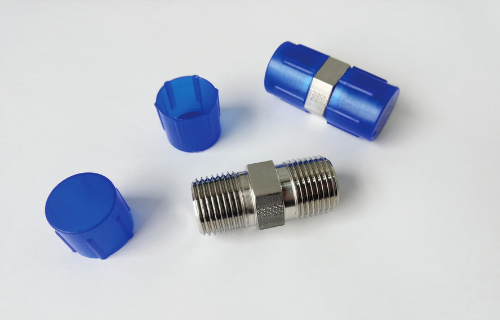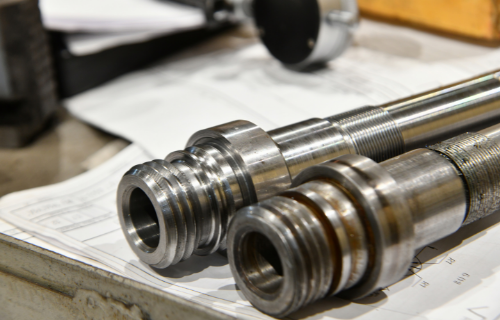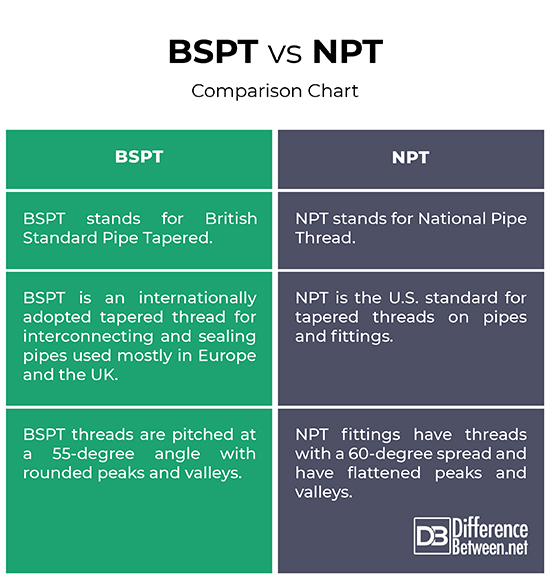Difference Between BSPT and NPT
The two most popular thread styles in the world are British Standard Pipe Tapered (BSPT) and National Pipe Thread (NPT). For those who do not know what pipe threads are, they are designed to provide connections for the transfer of fluids, gases, steam, or hydraulic fluid. Both BSPT and NPT threads are tapered, which aids in sealing. Process industries use different kinds of sealing for pressure systems depending on the geographical region, size of the pressure system, and the environment. Each style has its own share of pros and cons. We look at some key differences between the two thread styles.

What is NPT?
NPT, short for National Pipe Thread, is the US standard for tapered threads on pipes and fittings. These are the most common types of seals used in pressure calibration systems and are quite different from the thread on a regular bolt and nut because the thread is tapered. NPT fittings are not compatible with regular nuts and bolts. Male and female NPT threads may also be referred to as MNPT and FNPT (or MPT and FPT). The common nominal sizes for smaller props are 1/8, 1/4, 3/8, and 1/2.
Tapered pipe threads are, well, tapered, so measurements will vary depending on where you measure the thread diameter. The mail end is the shaft with threads around the outside, while the female end is the hole with threads on the inside. In case you have both of them of the same kind, you’ll need an adaptor to connect them together. NPT threads are separated at a 60 degree angle and have flattened peaks and valleys.

What is BSPT?
BSPT, short for British Standard Pipe Tapered, is an internationally adopted tapered thread for interconnecting and sealing pipes. It is used mostly in Europe and the UK. It is similar to NPT except some important differences. It refers to the parallel form of thread and to make a successful pipe joint at least one of the threads needs to be tapered. The BSPT threads are pitched at a 55 degree angle with rounded peaks and valleys.
Many different types of threads have been used for connecting steel tubes together since the introduction of steel as a piping material. But it wasn’t until Sir Joseph Whitworth developed his own engineering screwed thread in 1841 that a proper method was found. His thread quickly became the preferred method of producing a threaded screw and was adopted to form the basis of British Standard Pipe Thread, which soon became the internationally adopted standard.
Difference between BSPT and NPT
Standard
– National Pipe Thread (NPT) is the U.S. standard for tapered threads on pipes and fittings. These are the most common types of seals used in pressure calibration systems. As the name suggest, these are tapered threads rather than parallel threads. NPT fittings are not compatible with regular nuts and bolts. BSPT (British Standard Pipe Tapered) is an internationally adopted tapered thread for interconnecting and sealing pipes. It is used mostly in Europe and the UK.
Pitch
– BSPT threads and NPT threads are similar except the angle across the flanks of threads is slightly different. Also, the distance between the peaks on the threads is different on both the threads. The BSPT threads are pitched at a 55 degree angle with rounded peaks and valleys. NPT fittings have threads with a 60 degree spread and have flattened peaks and valleys. It is clear that these two different types of threads really aren’t compatible with each other.
BSPT vs. NPT: Comparison Chart

Summary
The British Standard Pipe Thread is abbreviated to BSP thread which refers to the parallel form of thread. The tapered version would normally be abbreviated to BSPT, and to make a proper pipe joint at least one of the threads needs to be tapered. The taper on the NPT threads allows them to form a seal when torqued as the flanks of the threads compress against each other. They are separated at a 60 degree angle and have flattened peaks and valleys. The BSPT threads feature a 55 degree thread angle and therefore, cannot be used with NPT threads. Thread sealant is usually required when assembling BSPT fittings.
Are BSPT and NPT compatible?
BSPT threads feature a 55-degree thread angle as opposed to NPT threads, which are separated at a 60-degree angle. Therefore, BSPT threads cannot be used with NPT threads, and these two different types of threads really aren’t compatible with each other.
How can you tell the difference between BSP and NPT?
BSP refers to the parallel form of thread whereas NPT is a tapered thread. The thread forms are different, and they have a different pitch. BSPT threads are pitched at a 55-degree angle whereas NPT fittings have threads with a 60-degree spread.
Can you convert BSP to NPT?
NPT threads are angled at 60 degrees while BSPT threads are angled at 55 degrees, which means BSPT male fitting can be tighten down to an NPT female. The problem is they won’t seal.
- Difference Between Caucus and Primary - June 18, 2024
- Difference Between PPO and POS - May 30, 2024
- Difference Between RFID and NFC - May 28, 2024
Search DifferenceBetween.net :
Leave a Response
References :
[0]Mavrigian, Mike. High Performance Fasteners and Plumbing: A Guide to Nuts, Bolts, Fuel, Brake, Oil and Coolant Lines, Hoses, Clamps, Racing Hardware and Plumbing Techniques. New York, United States: Penguin Group, 2008. Print
[1]Hart, Eric. The Prop Effects Guidebook: Lights, Motion, Sound, and Magic. New York, United States: Routledge, 2018. Print
[2]Duffy, Owen C., et al. Fundamentals of Mobile Heavy Equipment. Massachusetts, United States: Jones & Bartlett, 2017. Print
[3]Madsen, David A. Print Reading for Engineering and Manufacturing Technology. Massachusetts, United States: Cengage, 2011. Print
